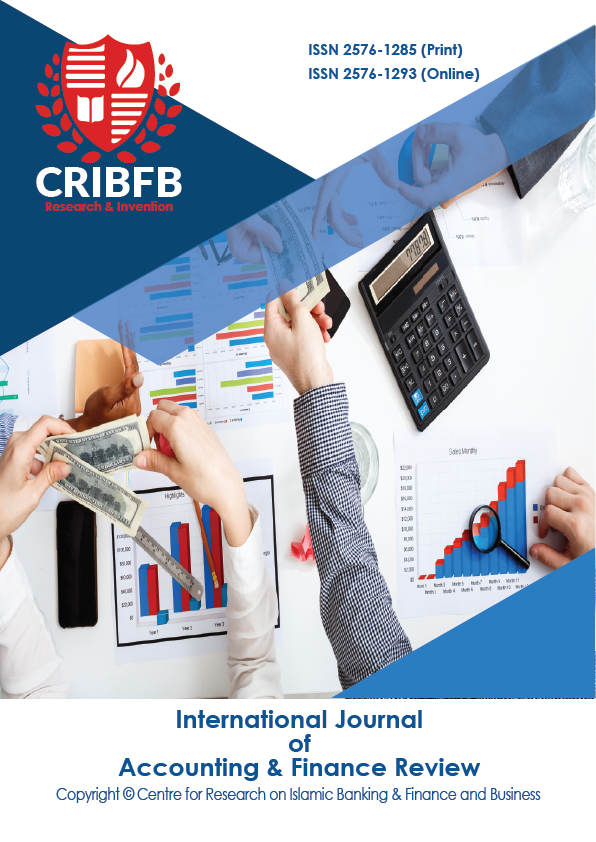THE IMPACT OF ENVIRONMENTAL LIABILITIES ON THE STOCK PRICE AND MARKET VALUE
Main Article Content
Abstract
This study examines the effect on the security returns of a company named on the National Priority List (NPL) for the Superfund site. It investigates if the designation as a potentially responsible party (PRP) generates more negative abnormal returns after listing the NPL. Since this designation of firms as PRPs increase regulatory costs such as cleanup costs and disclosure requirements, an adverse market reaction is expected. This study employs several financial databases, such as Research Insight, CRSP, I/B/E/S, and the EPA's NPL database, which compile the Superfund listing for each firm in the sample. In the case of environmental liabilities, the potential future cost of environmental remediation makes estimating the firm's earnings more difficult. This implies that the earnings of PRP firms may not persist, resulting in noisier accounting information. The empirical results support the hypotheses that the markets react negatively to the bad news that the firm has been designated as a PRP in the Superfund site, implying that environmental liabilities negatively impact firm stock price and valuation. Significant findings provide financial statement users with helpful information about contingent environmental liabilities and help them make more informed investment decisions and better judge the firms' future performance.
JEL Classification Codes: G1, G2, G3, M41, M48.
Downloads
Article Details
Section
How to Cite
References
Bae, B., & Sami, H. (2005). The effect of potential environmental liabilities on earnings response coefficients. Journal of Accounting, Auditing & Finance, 20(1), 43-70. https://doi.org/10.1177/0148558X0502000103
Barth, M. E., & McNichols, M. F. (1994). Estimation and market valuation of environmental liabilities relating to superfund sites. Journal of Accounting Research, 32, 177-209. https://doi.org/10.2307/2491446
Blacconiere, W. G., & Northcut, W. D. (1997). Environmental information and market reactions to environmental legislation. Journal of Accounting, Auditing & Finance, 12(2), 149-178. https://doi.org/10.1177/0148558X9701200203
Braiotta Jr, L. (1994). Environmental liabilities and contingencies: an empirical investigation of the type of independent auditors' reports. In Proceedings of the Northeastern AAA Regional Meeting (Vol. 126).
Cahan, S. F., Chavis, B. M., & Elmendorf, R. G. (1997). Earnings management of chemical firms in response to political costs from environmental legislation. Journal of Accounting, Auditing & Finance, 12(1), 37-65. https://doi.org/10.1177/0148558X9701200103
Campbell, K., Sefcik, S., & Soderstrom, N. (1994, August). Superfund settlement and firm valuation. In Collected Abstracts of the American Accounting Association Annual Meeting (pp. 10-13).
Chava, S. (2014). Environmental externalities and cost of capital. Management science, 60(9), 2223-2247. https://doi.org/10.1287/mnsc.2013.1863
Cole, E., Brozovsky, J., & Kubin, K. (1994). Disclosure of environmental liabilities in the usa: A research note. In Proceedings of the MidAtlantic AAA Regional Meeting. Atlantic City, NJ.
Collins, D. W., Rozeff, M. S., & Dhaliwal, D. S. (1981). The economic determinants of the market reaction to proposed mandatory accounting changes in the oil and gas industry: A cross-sectional analysis. Journal of Accounting and Economics, 3(1), 37-71. https://doi.org/10.1016/0165-4101(81)90034-3
Duke, J. C., & Hunt III, H. G. (1990). An empirical examination of debt covenant restrictions and accounting-related debt proxies. Journal of accounting and Economics, 12(1-3), 45-63. https://doi.org/10.1016/0165-4101(90)90041-2
Elbannan, M. A. (2003). An empirical model of the relationship between the environmental remediation expense recognition and accounting accruals and the effect on the earnings response coefficient, Dissertation, Southern Illinois University at Carbondale, ProQuest Dissertations Publishing, 3120911.
Espahbodi, H., Strock, E., & Tehranian, H. (1991). Impact on equity prices of pronouncements related to nonpension postretirement benefits. Journal of Accounting and Economics, 14(4), 323-346. https://doi.org/10.1016/0165-4101(91)90007-B
Espahbodi, R., & Tehranian, H. (1989). Stock market reactions to the issuance of FAS 33 and its preceding exposure drafts. Contemporary Accounting Research, 5(2), 575-591. https://doi.org/10.1111/j.1911-3846.1989.tb00725.x
Easton, P. D., & Zmijewski, M. E. (1989). Cross-sectional variation in the stock market response to accounting earnings announcements. Journal of Accounting and economics, 11(2-3), 117-141. https://doi.org/10.1016/0165-4101(89)90003-7
Freedman, M., & Jaggi, B. (1986). An analysis of the impact of corporate pollution disclosures included in annual financial statements on investors’ decisions. Advances in public interest accounting, 1(2), 193-212.
Ilinitch, A. Y., Soderstrom, N. S., & Thomas, T. E. (1998). Measuring corporate environmental performance. Journal of accounting and public policy, 17(4-5), 383-408. https://doi.org/10.1016/S0278-4254(98)10012-1
Johnson, L. T. (1993). Research on environmental reporting. Accounting Horizons, 7(3), 118. Retrieved from https://www.proquest.com/openview/466d5568c88d71f77115cbd7463997c5/1?pq-origsite=gscholar&cbl=3330
Johnson, M. F. (1995). The disclosure and valuation of environmental capital expenditures. Working Paper. University of Michigan. Retrieved from https://ssrn.com/abstract=55772
Konar, S., & Cohen, M. A. (2001). Does the market value environmental performance?. Review of economics and statistics, 83(2), 281-289. https://doi.org/10.1162/00346530151143815
Little, P., Muoghalu, M. I., & Robison, H. D. (1995). Hazardous waste lawsuits, financial disclosure, and investors' interests. Journal of Accounting, Auditing & Finance, 10(2), 383-398. https://doi.org/10.1177/0148558X9501000213
Moneva, J. M., & Cuellar, B. (2009). The value relevance of financial and non-financial environmental reporting. Environmental and Resource Economics, 44(3), 441-456. https://doi.org/10.1007/s10640-009-9294-4
Naj, A. K. (1988). See No Evil; Can $100 Billion Have ‘No Material Effect’on Balance Sheets?. The Wall Street Journal, 1, 6.
Press, E. G., & Weintrop, J. B. (1990). Accounting-based constraints in public and private debt agreements: Their association with leverage and impact on accounting choice. Journal of accounting and economics, 12(1-3), 65-95. https://doi.org/10.1016/0165-4101(90)90042-3
Rockness, J. W. (1985). An assessment of the relationship between US corporate environmental performance and disclosure. Journal of Business Finance & Accounting, 12(3), 339-354. https://doi.org/10.1111/j.1468-5957.1985.tb00838.x
Shane, P. B., & Spicer, B. H. (1983). Market response to environmental information produced outside the firm. Accounting Review, 521-538. Retrieved from https://www.jstor.org/stable/246532
Voorst, V. B., & Woodbury, R. (1993). Toxic dumps: The lawyers' money pit. Time, 142(11), 63-64. Retrieved from https://www.elibrary.ru/item.asp?id=1867371
Watts, R. L., & Zimmerman, J. L. (1986). Positive Accounting Theory. Englewood Cliffs, NJ: Prentice-Hall. Watts, R. L., & Zimmerman, J. L. (1986). Positive accounting theory. Retrieved from https://papers.ssrn.com/sol3/papers.cfm?abstract_id=928677
Watts, R. L., & Zimmerman, J. L. (1990). Positive accounting theory: a ten year perspective. Accounting review, 131-156.




